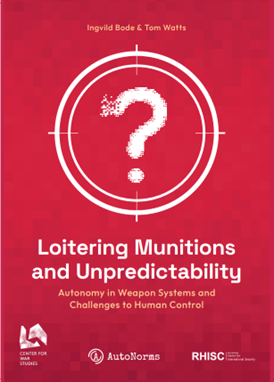AutoNorms
Weaponised Artificial Intelligence, Norms, and Order
An International Research Project
funded by the European Research Council (ERC), hosted by the Centre for War Studies (CWS) at the University of Southern Denmark (SDU)
An International Research Project
Weaponised artificial intelligence (AI) in the form of autonomous weapons systems (AWS) could diminish the role of meaningful human decision-making in warfare.
Today, states already use more than 130 systems that can autonomously track targets. But future autonomous weapons will increasingly include AI in their critical functions. Here, machines, rather than humans, will make life or death decisions. This development is likely to change international norms governing the use of force.
The EU-funded AutoNorms project will develop a new theoretical approach to study how norms, understood as standards of appropriateness, manifest and change in practices. It will investigate norm emergence and change across four contexts of practices (military, transnational political, dual-use and popular imagination) in the US, China, Japan and Russia. It will also review the impact AWS could have on the current international security order.
Funding
This project has received funding from the European Research Council (ERC) under the European Union’s Horizon 2020 research and innovation programme (grant agreement No. 852123).
Autonomous weapons systems could diminish the role of meaningful human decision-making in warfare.
Weaponised Artificial Intelligence, Norms, and Order
Weapon systems that integrate an increasing number of automated or autonomous features raise the question of whether humans will remain in direct, meaningful control of the use of force. Concerns relate, in particular, to weapon systems with autonomy in their critical functions – that is selecting, and engaging targets through sensors and algorithms without human input. Such autonomous features can take many different forms: we find them inter alia in loitering munitions, in aerial combat vehicles, in stationary sentries, in counter-drone systems, in air defence systems, in surface vehicles, and in ground vehicles. While diverse, these systems are captured by the catch-all category of autonomous weapons systems (AWS), because they weaponise Artificial Intelligence (AI).
Many states consider applying force without any human control as unacceptable. But there is less consensus about various complex forms of human-machine interaction along a spectrum of autonomy and the precise point(s) at which human control stops being meaningful. To illustrate, can human control that executes decisions based on indications it has received from a computer be considered meaningful, given that “blackboxed”, algorithmic processing is not accessible to human reasoning? Faced with these questions in the transnational debate at the UN Convention on Certain Conventional Weapons (CCW), states reach different conclusions: some states, supported by civil society organizations, advocate introducing new legal norms to prohibit so-called fully autonomous weapons, while other states leave the field of open in order to increase their room of manoeuvre.
As discussions drag on with little substantial progress, the operational trend towards including automated and autonomous features in weapon systems continues. A majority of the top 10 arms exporters such as the USA, China, and Russia, are developing or planning to develop some form of AWS. Such dynamics point to a potentially influential trajectory AWS may take towards changing what is appropriate when it comes to the use of autonomously applied force. Technologies have always shaped and altered warfare and therefore how force is used and perceived. Yet, the role that technology plays should not be conceived in deterministic terms. Rather, technology is ambivalent, making how it is used in international relations, and especially in warfare, a political question.
Learn more about AutoNorms
Read more about the questions driving our research, meet our team and explore our latest findings.
The AutoNorms research is organised in seven research themes. We regularly publish blogposts on our website that explores these key topics. Find our latest entries here below, or explore all research themes by clicking below.
Latest blogposts

Loitering Munitions and Unpredictability: Autonomy in Weapon Systems and Challenges to Human Control
Download the report here By Ingvild Bode and Tom Watts A new report published by the Center for War Studies, University of Southern Denmark and the Royal Holloway Centre for International Security highlights the immediate need to regulate autonomous weapon systems, or ‘killer robots’ as they are colloquially called. Written by

A Question of Trust? New US Initiatives to Tackle the Human Control Problem
A lack of or a substantially diminished quality of human control is often understood as the major problem associated with military AI. The US Department of Defense (DoD) ‘Directive 3000.09’ that was released in 2012 as one of the first political documents on autonomy in weapon systems, for example, states

‘Responsible AI’ in the Military Domain: Implications for Regulation
This blog is based on the regulation subpanel of the Realities of Algorithmic Warfare breakout session, held at the REAIM Summit 2023. Watch the full breakout session here. The global debate on military applications of artificial intelligence (AI) and autonomy is gradually expanding beyond autonomous weapon systems (AWS) towards the

AutoNorms at the UN GGE on LAWS in March 2023
The AutoNorms team regularly participates in meetings of the United Nations Group of Governmental Experts (GGE) on emerging technologies in the area of lethal autonomous weapons systems (LAWS). The GGE meetings take place in Geneva and bring together delegations of state parties to the UN Convention on Certain Conventional Weapons


